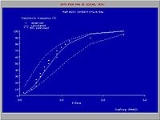
Hydraulic conductivity
Overview
 , is a property of vascular plants, soil or rock, that describes the ease with which water can move through pore spaces or fractures. It depends on the intrinsic permeability of the material and on the degree of saturation. Saturated hydraulic conductivity, Ksat, describes water movement through saturated media.
, is a property of vascular plants, soil or rock, that describes the ease with which water can move through pore spaces or fractures. It depends on the intrinsic permeability of the material and on the degree of saturation. Saturated hydraulic conductivity, Ksat, describes water movement through saturated media.There are two broad categories of determining hydraulic conductivity:
- Empirical approach by which the hydraulic conductivity is correlated to soil properties like pore sizePorosityPorosity or void fraction is a measure of the void spaces in a material, and is a fraction of the volume of voids over the total volume, between 0–1, or as a percentage between 0–100%...
and particle size (grain size)Particle size (grain size)Particle size, also called grain size, refers to the diameter of individual grains of sediment, or the lithified particles in clastic rocks. The term may also be applied to other granular materials. This is different from the crystallite size, which is the size of a single crystal inside the...
distributions, and soil textureSoil textureSoil texture is a qualitative classification tool used in both the field and laboratory to determine classes for agricultural soils based on their physical texture. The classes are distinguished in the field by the 'textural feel' which can be further clarified by separating the relative... - Experimental approach by which the hydraulic conductivity is determined from hydraulic experiments using Darcy's lawDarcy's lawDarcy's law is a phenomenologically derived constitutive equation that describes the flow of a fluid through a porous medium. The law was formulated by Henry Darcy based on the results of experiments on the flow of water through beds of sand...
The experimental approach is broadly classified into:
- LaboratoryLaboratoryA laboratory is a facility that provides controlled conditions in which scientific research, experiments, and measurement may be performed. The title of laboratory is also used for certain other facilities where the processes or equipment used are similar to those in scientific laboratories...
tests using soil samples subjected to hydraulic experiments - Field tests (on site, in situ) that are differentiated into:
- small scale field tests, using observations of the water level in cavities in the soil
- large scale field tests, like pump tests in wellsWater wellA water well is an excavation or structure created in the ground by digging, driving, boring or drilling to access groundwater in underground aquifers. The well water is drawn by an electric submersible pump, a trash pump, a vertical turbine pump, a handpump or a mechanical pump...
or by observing the functioning of existing horizontal drainageDrainageDrainage is the natural or artificial removal of surface and sub-surface water from an area. Many agricultural soils need drainage to improve production or to manage water supplies.-Early history:...
systems.
The small scale field tests are further subdivided into:
- infiltrationInfiltrationInfiltration may refer to:*Infiltration , a heating, ventilation, and air conditioning term for air leakage into buildings*Infiltration , downward movement of water through soil...
tests in cavities above the water tableWater tableThe water table is the level at which the submarine pressure is far from atmospheric pressure. It may be conveniently visualized as the 'surface' of the subsurface materials that are saturated with groundwater in a given vicinity. However, saturated conditions may extend above the water table as... - slug testSlug testA slug test is a particular type of aquifer test where water is quickly added or removed from a groundwater well, and the change in hydraulic head is monitored through time, to determine the near-well aquifer characteristics...
s in cavities below the water tableWater tableThe water table is the level at which the submarine pressure is far from atmospheric pressure. It may be conveniently visualized as the 'surface' of the subsurface materials that are saturated with groundwater in a given vicinity. However, saturated conditions may extend above the water table as...
Shepherd derived an empirical
Empirical method
The empirical method is generally taken to mean the approach of using a collection of data to base a theory or derive a conclusion in science...
formula for approximating hydraulic conductivity from grain size analyses:

where
 and
and  are empirically derived terms based on the soil type, and
are empirically derived terms based on the soil type, and is the diameter
is the diameterDiameter
In geometry, a diameter of a circle is any straight line segment that passes through the center of the circle and whose endpoints are on the circle. The diameters are the longest chords of the circle...
of the 10 percentile
Percentile
In statistics, a percentile is the value of a variable below which a certain percent of observations fall. For example, the 20th percentile is the value below which 20 percent of the observations may be found...
grain size of the material
Note: Shepherd's Figure 3 clearly shows the use of
 , not
, not  , measured in mm.
, measured in mm.

